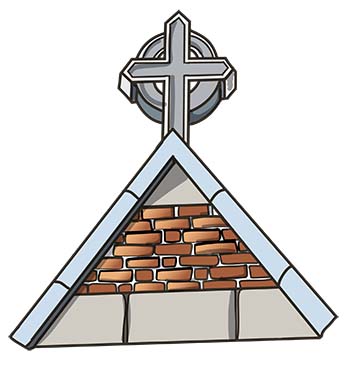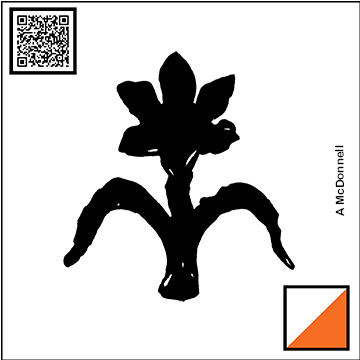Checkpoint 11: Nano Nagle Place
Checkpoint 11: Nano Nagle Place
Illustration of architectural feature close to the tile:


| This illustration marks our eleventh checkpoint and was drawn by local artist – Avril McDonnell. It is a depiction of the railings at Nano Nagle Place. |
Checkpoint 11: Nano Nagle Place
You have now arrived at Checkpoint 11, Nano Nagle Place.
Nano Nagle
Nano Nagle is one of Cork’s most famous women. Honora Nagle was born near Mallow in 1718 and educated in France. Nano became devoted to aiding the poor, and decided on a life of charitable and religious work. In 1754 she opened her first school in Cork, a mud cabin where poor girls learned to read and sew. By 1769 she had established seven schools where girls and boys were educated and given religious instruction. Nano opened the school here in 1771, aided by the Ursuline Sisters. In 1775 she established the Congregation of Presentation Sisters, dedicated to education, and became a nun herself in 1776. Nano Nagle passed away in 1784 having left a lifetime of charitable work behind her. She is buried in the Ursuline graveyard here at Nano Nagle Place.
A Convent Complex
The buildings that form the complex in front of you are representative of more than 250 years of religious and educational activity at this site. The red brick building that now dominates the streetscape was built as the Convent school in 1930. The bricks were laid out in a style known as “Flemish bond”, and the front of the building was elaborately finished with dressed limestone. Today it is the visitor entrance to the Nano Nagle museum, gardens, and restored convent. To your left, the red sandstone building that fronts directly onto the road represents part of the convent itself, built in 1895.
The History Within
Lying within this complex are a series of buildings that trace the story of this site all the way back to Nano Nagle herself. They include the original three-storey convent building dating to 1771 and extensions that were added in the late 1770s. These are identifiable by their slate pitched roofs and timber sliding sash windows, and are among the most historically significant buildings in Cork’s religious and educational history.
Feature Focus: The Tomb of the Venerable Nano Nagle
When Nano Nagle passed away in 1784 she was interred in the Ursuline Convent graveyard here, beside Ursuline and Presentation sisters who have lived and worked at this site over the generations. The monument above her remains incorporates Nano’s first grave slab, and includes a small door so pilgrims to the site can place their hands close to the remains of this holy woman.
Looking Around: A Classic Cork Laneway
Nano Nagle Place sits in the heart of the South Parish, one of Cork’s most historic and distinctive areas. Keep your eye out for one of the city’s most charming laneways, Green Field Lane, just across from the convent. The limestone steps there have been carrying people through the laneway since 1825. They date to the same period as the limestone steps on nearby Travers Street, which have served Cork pedestrians for the last 200 years.
| Clue: Find Cork’s oldest upstanding building! |




